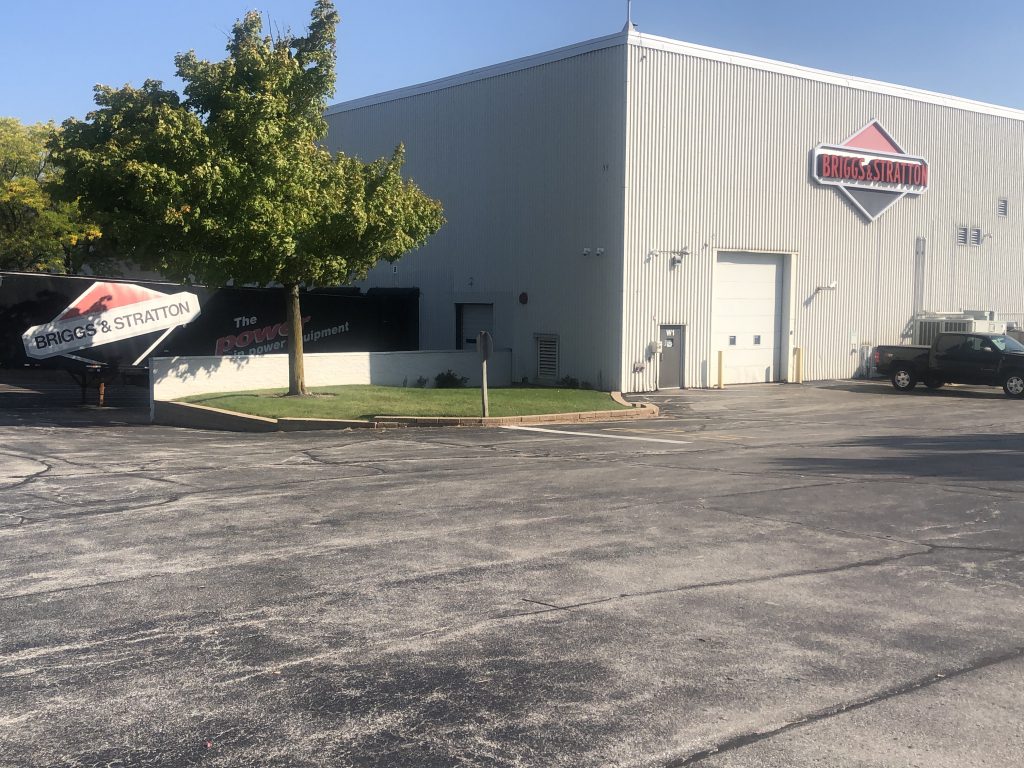Why Briggs & Stratton Went Bankrupt
A story of greed, mismanagement and union busting.
Just days before filing for bankruptcy in July, Milwaukee’s Briggs & Stratton Corp., at one time the largest producer of small engines in the world and employer to 11,000 union production workers making a solid, middle-class living, handed its top executives $5 million in bonuses, calling them “retention awards.”
In mid-September a federal bankruptcy court judge approved the sale of Briggs & Stratton’s assets to KPS Capital Partners, a private equity firm.
Like vultures picking a carcass clean, these bonuses in the run-up to bankruptcy have become an all-too-frequent way for corporate executives to gift themselves with one last, egregious payday before stiffing their workers and creditors.
The story of how Briggs got to this point is a morality tale about modern American industrial capitalism. Briggs embodies the anti-union race to the bottom characterized by contempt for hourly workers, mismanagement and misjudging markets.
Briggs managers lost the race, dragging their employees down with them.
Corporate class warfare
To understand Briggs’ decline we have to go back to the early 1970s when corporate attorney Lewis Powell drafted his infamous memo to the U.S. Chamber of Commerce urging the business class to become more “aggressive” and “pursue political power.” Business Week recognized the impact of Powell’s call to arms in its October 12, 1974 issue: “Some people will obviously have to do with less … it will be a bitter pill for many Americans to swallow the idea of doing with less so that big business can have more.”
Powell’s message was pursued by corporate management with such intensity that United Auto Workers President Douglas Fraser decried the “one-sided class war” being waged by capital against labor. Then in 1981, new President Ronald Reagan entered the fray by forcing a strike by the Air Traffic Controllers union before firing them all. Union busting was now supported in the White House, by a former union president at that, as the Reagan era of corporate greed with no social responsibility commenced.
Forced strike in ’83 a turning point
Even though it was an extremely profitable company in 1983, Briggs declared virtual war on its employees, demanding unprecedented concessions such as a two-tier wage system, three-year wage freeze, elimination of personal days and the ability to subcontract work to non-union companies.
At the time, Fred Stratton, Briggs’ President and CEO, claimed the concessions were necessary because of lower wages paid by foreign competition, singling out Japanese manufacturers. While Briggs’ labor costs were indeed higher, Stratton’s claim was a canard.
Briggs wasn’t alone in playing this shell game and going after its union employees. A May 1982 Business Week poll of 400 executives from top companies indicated that 19% admitted, “Although we don’t need concessions, we are taking advantage of the bargaining climate to ask for them.”
Briggs wasn’t always so virulently greedy and anti-union. A decade earlier in 1974, Allied Industrial Workers Local 232 also struck Briggs. However, at that time, management accepted the walk-out as a legitimate, although undesirable, collective bargaining tactic. That strike was settled on classic union-management terms: both sides presented positions, they whittled away provisions from each other’s offers, and eventually arrived at a new contract. It was what labor-management bargaining is supposed to be: a negotiation.
Hired union-busting lawyer
But the combination of greed, “bargaining environment” opportunism, and hubris led Briggs to an all-out assault on its workforce in 1983. It hired the notorious union-busting attorney Tom Krukowski, who had earned his spurs helping to break the Milwaukee Packing House Workers strike in 1975 and rose to national prominence for his role in the 1985 Hormel strike.
Under Krukowski’s direction, Briggs first forced the strike by its draconian demands, then began recruiting replacement workers, and threatened to replace employees if they did not submit to company demands. It also began moving its lock-and-key production to a non-union plant in Georgia. This was too much even for the conservative Milwaukee Sentinel, which opined, “the threat was a common practice in Texas, but new to Milwaukee.”
After ninety days Local 232 conceded. The Milwaukee Journal called it a management “victory with a contract tipped by an unsheathed bayonet — the threat of firing 7,600 workers…” Even with all the concessions the union made to keep the plant open, Briggs still announced that it would open a new non-union facility in Murray, Ky., in a plant given to the company by the city.
Briggs’ management continued these zero-sum tactics. Between 1983 and 1995 Briggs’ workers repeatedly gave concessions in an effort to save their jobs. Briggs’ workers’ real income declined by 30% according to The Milwaukee Journal. Yet Briggs and Stratton continued to relocate production out of Milwaukee to non-union southern states, Mexico and China.
Flawed Business Strategy
It’s safe to say that this sea-change in attitude toward union workers was fueled by a flawed business strategy and a failure by Briggs’ leadership to read the markets for its products. Both CEO Fred Stratton and John Shiely, Vice President of Strategic Planning and Corporate Counsel (and later Stratton’s successor as President and CEO), came from finance backgrounds. Although Stratton’s grandfather, Harold Stratton, was co-founder of the company, Fred Stratton didn’t grow up in the company. He came to it after several years working in private equity with Robert Baird. Shiely was an Arthur Anderson tax accountant before his Briggs & Stratton employment. Neither were manufacturing men with a vision and passion for building things nor a commitment to innovation.
The two of them were apostles for a management philosophy, Economic Value Added (EVA), that claims to align the interests of management with shareholders by structuring business to seek the highest possible rates of profits. This strategy minimizes long-range planning and ignores workers’ expertise, treating them as nothing but numbers.
Stratton and Shiely were so focused on trying to squeeze more concessions and profits out of their hourly employees that they missed all the changes in the marketplace. Lawnmowers using Briggs’ engines were once sold almost exclusively through high-priced dealers with well known brand names like Toro, Snapper, Jacobsen and Lawn Boy. Those dealers would charge $300 for a lawnmower with a Briggs engine in it.
That changed in the 1990s when massive, big-box retailers like K-Mart, Walmart, Home Depot and Farm and Fleet started seizing market share and squeezing manufacturers. Walmart was the king of this approach, dictating to manufacturers what it would pay for their products. Now those same $300 lawnmowers were going for $129, the dealer stores were going out of business, and the only way Briggs could keep profits up was to cut their labor costs even more.
Fred Stratton reflected on this changed dynamic in a speech at a 1996 Robert Baird award luncheon. “This shift in relative power from manufacturer to retailer has greatly increased the relative importance of price. This increased the importance of being a low-cost producer and added urgency to our need to achieve our cost goals.”
Briggs had actually flirted with an alternative strategy. In the late ’80s it announced plans to produce a high-value-added engine for the top end of the market. It was an effort to compete based on performance, quality and features rather than low price. Local 232 agreed to work rule changes to support the effort because it was a chance to stabilize family-supporting employment in Milwaukee.
But Stratton and Shiely excluded workers from participating in the design of the project and treated it as a simple automation experiment. Predictably, after ignoring the skill and knowledge of the workers on the shop floor, management bought the wrong machinery.
The effort failed; after only a few years it was abandoned and soon outsourced to Mitsubishi. Stratton justified abandoning the project by citing “our revised strategy” of producing high-volume, low-cost, small engines with a manageable number of features and “EVA discipline.” This was the very strategy that was to bring them down.
Management keeps misreading market dynamics
Stratton, Shiely and the rest of Briggs’ management missed yet another development in the marketplace. In the early 1990s there was a growing consciousness of environmental damage done by emissions from even small gasoline-powered engines, and a growing interest in the industry to respond to that by developing battery-powered lawnmowers or less polluting engines. Briggs’ management was so addicted to the model of low-cost, high-volume, standardized production with its low wages that company executives didn’t even consider it. Instead they teamed up with Missouri Sen. Kit Bond (R-Mo.) in an unsuccessful fight to undermine California’s emission standards.
In a 1991 interview for a City of Milwaukee project designed to keep manufacturing jobs in the city, Shiely was asked about the potential for producing green or premium engines. He rejected the idea, implying it was unnecessary for Briggs to innovate. He stated that if those markets emerged, Briggs would simply buy the innovating company.
The other strategy Briggs management pursued was to buy up other companies. In 2000 it bought Generac Portable Products Systems. Over the next decade and a half it acquired a total of five separate companies including Simplicity, a leader in the production of premium engines. The buying spree lacked strategic focus and ultimately failed to turn around the company’s decline.
Rather than investing in research and innovation, Briggs’ management tried to buy success while continuing to enrich its executives and stockholders. According to its securities filings, the company has spent only $167 million on research and development since 2012 while devoting $239 million to buying back its own stock to inflate the price of the shares held by management and investors.
The downward spiral of Briggs resulting from such arrogance is well documented. When Ronald Reagan was elected president in 1980, Briggs had four manufacturing plants in the Milwaukee area and 11,000 unionized employees.
Over the next 35 years it opened and closed plants in Milwaukee, Missouri, Kentucky, Tennessee, Alabama and other locations, either moving that production to China or simply downsizing. When the company emerges from bankruptcy, only 300 hourly employees will remain in the Milwaukee area.
Briggs managers’ struggle to find a direction was summarized recently in the Milwaukee Journal Sentinel by industry analyst Tom Hayes of Northcoast Research, “It’s been, ‘Let me turn this dial and turn that dial.’”
Management takes bonuses but no responsibility
Declining sales, looming debt payments, then the COVID-19 pandemic with its dramatic drop in lawnmower sales all combined to finally push the company into Chapter 11. Sales for the second quarter of 2020 were down by $107 million, or 18%, over the same period last year. The third quarter results are expected to be even worse.
Despite obvious mismanagement, Briggs’ board of directors in July made “cash retention awards” of $1.2 million to CEO and Chairman Todd Teske, $600,000 to Senior VP Mark Schwertfeger and lesser amounts to other executives. Although the new owners abruptly dismissed Teske on Sept. 22, he could still hang on to some or all of his $8.8 million golden parachute, bankruptcy attorneys suggested to the Milwaukee Business Journal.
After taking care of its top dogs, what did Briggs do for its investors and hourly employees? Instead of generosity, there was only contempt.
As Brown Rudnick lawyer Robert Stark, who represents unsecured creditors in the Briggs & Stratton bankruptcy case, said about Briggs’ management: “They pay themselves large bonuses, stick it to the rank and file and don’t pay their bondholders.”
Congress in 2005 tried to curb payouts to executives when a company is in distress, restricting executive bonuses when a company declares bankruptcy. In response, these pre-bankruptcy “retention” bonuses were designed as an end-run around that law. “It’s regulatory evasion,” according to Jared Ellias, a law professor at the University of California Hastings College of the Law.
Today Milwaukee is one of the poorest, most segregated cities in the country. Briggs long ago abandoned its two factories on the North Side, home to most of its Black workers. It sold most of its large suburban manufacturing plant in the western suburb of Wauwatosa. A Lowes department store now sits where workers used to make small engines.
The decision by Stratton, Sheily and their successors to compete based on low wages, their refusal to develop innovative products, and their self -defeating war against their employees has cost the community dearly.
By paying themselves engorged bonuses in 2020, Briggs’ current management is behaving in a way totally consistent with its predecessors. While corporate executives who preside over failure often find someone else to blame, Briggs’ demise has, in reality, directly resulted from its executives’ mismanagement, greed and pathological animosity towards the unionized workers who had made them rich.
Reprinted with permission of Wisconsin Examiner.
If you think stories like this are important, become a member of Urban Milwaukee and help support real, independent journalism. Plus you get some cool added benefits.






















We could probably make a list of some of the late great Milwaukee manufacturing firms which mismanaged their way into oblivion. My dad worked at Allis-Chalmers and when they went down they took his pension with them.
I think the Brigg’s approach to business is still prevalent today and enabled by Republican supported tax giveaways and TIFs. The economic world is changing rapidly and business polices enacted over the last ten years in Wisconsin by the Republicans have supported industries companies like Briggs and ignored bringing in companies like EPIC. Very little has been done for rural economic development.
Hats off to Mike and Charlie for this sad eulogy for a once proud local company and its unionized work force. Again, rapacious management and soulless “investors” combine to destroy thousands of our neighbors jobs (see Allis- Chalmers, AO Smith, et al). There was nothing inevitable about this story, but we’ve heard it too many times in Milwaukee.
There is an old movie that just played this past weekend on TCM It is named “executive Suite” A board room drama. It is the movies and the good guys won and the company would continue.
This is a great, heartbreaking explanation of an oft-told tale. The very “ white, non-college educated”
workers who were screwed – and who plan to vote for trump should read this- but they won’t, right?
Thanks. May a rising tide lift all boats.
When I saw this I thought of Allis Chalmers but someone beat me to it. The president primary goal was to break the union and instead the community lost a major employer.
I was about to mention American Motors but they went under because people stopped buying their crappy cars.
Add Schlitz, Pabst, Square D and Kearney & Trecker to the list.
The landscape of Milwaukee is covered with the ashes of companies that never updated their business plan, or chose an ill-advised path.